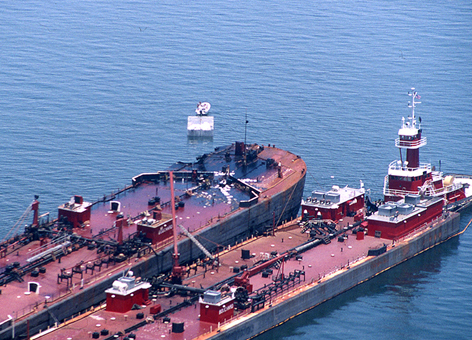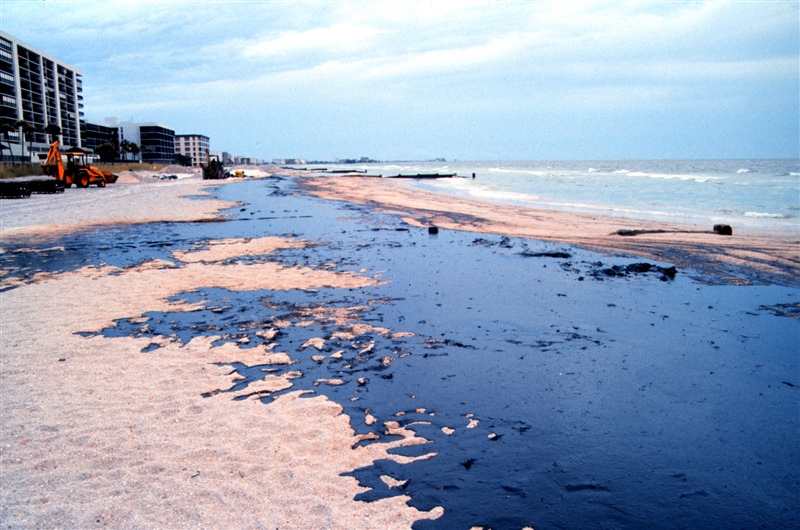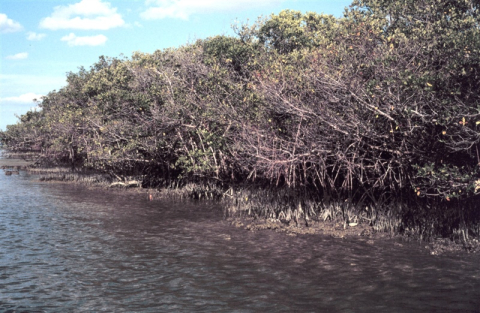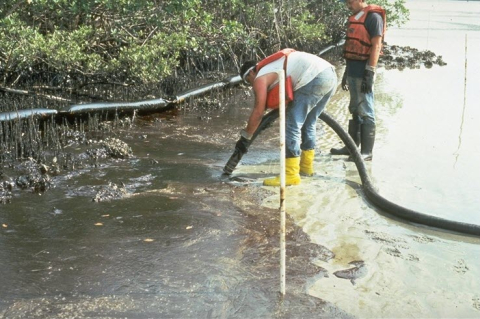Doug Helton is the Regional Operations Supervisor for OR&R’s Emergency Response Division. He is based in Seattle, WA.

Thirty years ago, I spent much of the month of August on the beaches of Pinellas County, Florida. But not fishing and sunbathing.
Recently, I was conducting a training class in Portland, Oregon, and as I went through some old case histories about oil spills and shoreline cleanups, I was reminded of a significant spill incident in Tampa in August 1993. Some of the major impacts were to recreational beaches and to shoreline vegetation (in that case, mangroves), and, despite decades passing by, we continue to use photos from that incident to illustrate the challenges and trade-offs of shoreline cleanup.
A Complicated Collision
Three vessels—the freighter Balsa 37, the barge Ocean 255, and the barge Bouchard 155—collided near the entrance of Tampa Bay, Florida on August 10, 1993. While the incident is known as a three-vessel collision, there were actually six vessels involved in the collision because the two barges were assisted by three towing vessels. In the immediate aftermath, two additional vessels, the Tampa Bay pilot boats Egmont and Manatee, rushed to render assistance and rescue the crews that had abandoned ship.
Several crew suffered burns, but luckily there were no fatalities despite some close calls. One crewmember recounted that, while in the water awaiting rescue, a wall of flame on the water's surface blew towards the survivors. He considered removing his PFD (“personal flotation device” or life jacket) to dive under the approaching fire. As the wall of fire approached, a 20-30 foot "break" in the flames appeared. The survivors swam towards the break, and the fire passed them on both sides.
It sounds like the kind of complicated scenario we use in spill planning exercises, but in this case, within a few minutes, all of these vessels were either on fire, abandoned, grounded, or spilling oil.
The U.S. Coast Guard (USCG) investigation into the circumstances surrounding the collision included this terse Finding of Fact, recounting the basic scenario:
Before dawn on 10 August 1993, the tug CAPT. FRED BOUCHARD was pushing the petroleum-laden barge B. NO. 155, and was inbound in Egmont Channel, Tampa Bay, Florida. An assist tug, the EDNA ST. PHILLIP, was made up to the B. NO. 155, as the CAPT. FRED BOUCHARD had suffered a starboard engine casualty. The Integrated Tug Barge SEAFARER and OCEAN 255, with a mixed cargo of petroleum products, was also inbound and following astern of the BOUCHARD tow. The M/V BALSA 37, having departed Port Manatee, Florida was outbound in Mullet Key Channel carrying 6000 metric tons of phosphate product. Under fair skies, the wind was northeast at 12 knots and visibility was 10 to 12 miles.
At approximately 0545, the starboard bow of the OCEAN 255 struck the starboard side of the BALSA 37. The impact ruptured the No. 1 starboard tank of the OCEAN 255, igniting its cargo. The SEAFARER crew abandoned ship and was rescued by the Tampa Bay pilot boat MANATEE. The BALSA 37 suffered extensive damage along its starboard side and cargo holds. The BALSA 37 separated from the OCEAN 255 and then collided with the BOUCHARD tow less than one minute later, rupturing the B. NO. 155's No. 1 port tank. 5000 barrels of No. 6 oil were released. The collision damaged the bow of the BALSA 37, rupturing its forepeak tank. The SEAFARER tow grounded near Fort De Soto Park. Its No. 6 starboard tank exploded and the fire burned out of control until extinguished by the Tampa Fire Department that evening. The BALSA 37 was grounded south of the channel near Egmont Key to prevent sinking. The BOUCHARD tow proceeded to anchorage near the Sunshine Skyway Bridge while continuing to release oil.
The collision resulted in a fire on one of the barges and caused a major oil spill. Over 32,000 gallons of jet fuel, diesel, and gasoline, and about 330,000 gallons of heavy fuel oil spilled from the barges. Despite emergency cleanup efforts, the oil fouled 13 miles of beaches and caused injury to birds, sea turtles, mangrove habitat, seagrasses, salt marshes, shellfish beds, as well as closing many of the waterways to fishing and boating.
A Comparatively “Smaller” but Important Spill
In 2010, after the Deepwater Horizon oil spill, we received many questions about other big spills in the Gulf of Mexico. We put together a quick fact sheet of other large incidents (PDF download), and the Tampa spill made the list—but barely.
Small compared to the Deepwater Horizon and the 1979 Ixtoc I oil spill, the Tampa Bay spill was still a major incident and one that I had been preparing for. The prior year, I had been hired by NOAA and tasked with developing a Rapid Assessment Program (RAP) to provide a quick response capability for oil and chemical spill damage assessments, focusing on the collection of perishable data and information, photographs, and videotape in a timely manner to determine the need for a natural resource damage assessment.
The emergency nature of spills requires that this type of information be collected within hours after the release. Time-sensitive data, photographs, and videotape are often critical when designing future assessment studies and initiating restoration planning—and are also used later as evidence in support of Natural Resource Damage Assessment (NRDA) claims. The Tampa Bay spill was one of the first major responses for the RAP team.
The Tampa Bay NRDA case was settled long ago and restoration projects have all been implemented to address the ecological and socioeconomic impacts of the spill. But some of the damage assessment approaches developed during that incident are still used today, and some of the then-innovative restoration approaches are now more common.
This spill incident was also significant in the refinement of OR&R’s spill modeling tools. Oil spill trajectory models rely on data about the wind, weather, currents, and tides to help estimate the movement and extent of a spill. Back in 1993, we used our trajectory model, OSSM (On-Scene Spill Model), the precursor to our GNOME suite of spill transport and weathering tools, to estimate oil movement when spilled. In this spill event, the wind and currents were both forecast as “weak and variable,” with the region outside Tampa Bay having a stronger and less predictable sea-breeze effect, which made our estimation highly challenging. Oil traveled to regions that we didn’t expect, prompting the development team to include “uncertainty bounds” in our display, to indicate other locations where oil potentially could be located. Today, uncertainty bounds in our trajectory display are important features to account for changes in currents, winds, and other conditions affecting the spill.
The Vessels, Post-Spill
Looking back at the incident 30 years ago, most of the vessels involved are also long gone. The Balsa 37 was reflagged in Malta and renamed the Able Inspector and then the TK Venice, which was later lost or scrapped (source: balticshipping.com).
The barge Ocean 255 was renamed the Ocean Ruler and later scrapped after a collision in 1994 (source: shipbuildinghistory.com).
The B-155 had a more notorious history. It was built in 1979, well before the double-hull requirements in the Oil Pollution Act of 1990. In 2000, the barge was rebuilt as a double-hull, which enhances the safety of the vessel, and renamed the B-255. On October 20, 2017, it suffered a fire and explosion near Port Aransas, Texas, killing both crewmembers. About 2,000 barrels of crude oil were discharged from the barge or consumed in the ensuing fire. (I also worked on that spill, but as a supervisor from my desk in Seattle.) The barge sustained more than $5 million in damage and was scrapped after the accident.
Maritime accidents take place in seconds or minutes, but they have a long tail. The crew in the water were rescued in less than an hour. The fires burned for most of a day, the cleanup took months, and the restoration took years.
Today, the response to the Tampa Bay spill has a strong legacy for providing the foundation for current, critical emergency response and damage assessment techniques.





